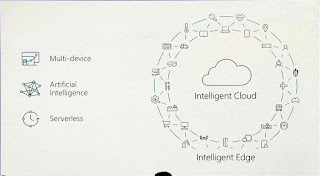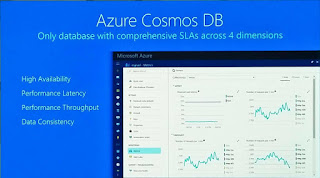Watching beats reading – so take a look at this video first:
No chance to watch – here is the one slide summary:
Keep reading on my top takeaways:
Azure DB support grows – Microsoft realizes how important databases are for the enterprise – and always has key database related news in store for Build, think back 2014 with running Oracle (on Linux) on Azure, Azure DB (2015), SQL Server DataLake (2016) etc. This year it was support for PostgreSQL and MySQL on Azure, the former found less applause from the audience than what I expected. But the key DB announcement was Cosmos DB, which is the latest version of DocumentDB, but so souped up, that Microsoft felt it warrants a new name. It’s a single interface for running worldwide distributed NoSQL, not only on DocumentDB, but also on MongoDB. The SLAs for this are close to fantastic, in less than 0.1s synch time across data centers around the world. One can wonder why Microsoft did this – but read on. Microsoft positioned Cosmos DB as multi modal, which is fair for the multiple flavors of NoSQL that are supported – but not so much for the 30k feet view on this which is the combination of SQL and NoSQL. But only what isn’t can still happen, we will see if Microsoft expands this to relational support (maybe combining the new PostgreSQL / MySQL abilities with MS SQL Server).
| Nadella opens Build |
Visual Studio gets richer, help the doers – Build is a developer conference, and the tool that Microsoft wants developers to use is Visual Studio. So, providing Visual Studio on more platforms (Mac Support), grasping Azure innovation (Azure Functions, container support) are all moves that are expected from Microsoft, but also boost productivity. Creating a UI abstraction layer to go along with Xamarin value proposition is more value along those directions. More Linux support coming to Windows 10 means it’s easier for developers to test on the same machine… and now they can even listen to their iTunes music (coming to the Windows Store). CLI support for the Azure console is equally something developer and sys admins will like, though CxOs may be less enthusiastic. And no conference without CI / CD where it gets easier to deploy and integrate code – in the extreme case all the way to the IoT edge, courtesy of a container.
 |
| The Intelligent Cloud |
Azure Stack – Microsoft keeps hearing from customers that data residency is crucial, and no IaaS provider can have data centers in all countries yet, which requires close to 100 locations (estimated on current legislative and performance restrictions). So, Azure stack remains crucial for Microsoft – which is not playing the cloud only game – and uptake should be seen this summer. The re-start with partners (vs first party – how Microsoft calls hardware it builds itself) is almost there. Carnival Cruise lines was the poster customer for Azure stack. The real test will be for Microsoft to get the right subset of the overall Azure available in Azure stack. With Microsoft SaaS offering like Dynamics for Operations coming to Azure stack – this will be an offering with many (maybe too many) settings. Future will tell.
 |
| Azure Cosmos DB Capabilities |
Bot Framework and AI are ready – No conference without AI, which really means machine learning. Impressive live translation demo with Cortana, and the plan to provide each user its very own neural network for speech recognition. And after launching the bot framework last year and Microsoft seeing good – but for its size only lukewarm – uptake, Microsoft is doubling down on its framework efforts, making it even easier for a non-AI, non-data scientist developer to build speech enabled bots. Unfortunately, the CaaP message from 2016 was heard only gingerly – hopefully not a disconnect.
Tidbits
Windows 10 – Microsoft is doubling down on the creative side, with another Creator version coming in fall. The 3D remix, content sourcing, Story remix (is it the Moviemaker of the 21st century?) are all well done, built. A new graphics library makes rendering smoother, all good innovation. But I wonder if Microsoft is pushing too far on the creative side – vs the consumer of information side. We will see.Microsoft Graph – The real big news to stay for the next decade is Graph. From the humble beginnings in Delve, it is now the graph of all things Microsoft. Not only people, but devices – all the way down to the single file (here is why Microsoft needs Cosmos DB, in my view). It’s available as REST API to developers, with fine grained permission based access control and is basically becoming the meta model and storage model of all things Microsoft.
MR vs VR – Past Builds have been dominated by the Microsoft ‘headable’ (as I call the PC aka Hololens) – not this time. Yes, a partnership with Cirque du Soleil was a nice demo, but no new spec, no Hololens 2, no adoption numbers. Even more interesting, a partner based low cost VR offering, using Hololens assets like location and motion sensors, is coming in fall / for the Christmas sales season. But it is a VR experience, not the touted MR (Mixed Reality). Under normal circumstances the cost for Hololens should be in a similar range by now – future will tell why Microsoft did this substantial change or at least addition in strategy.
IoT – Microsoft sees a lot of IoT scenarios, no surprise it is one of the most popular seven universal next generation application use cases that we see. Being able to get more code to the edge of IoT is a good step, that should make it easier for enterprises to propagate their code across their IoT networks. What I missed are more templates, e.g. for vertical use cases, and maybe partnerships with IoT end point makers.
Azure Fabric – The hidden platform behind Azure is the compute fabric, which is the magic sauce of any IaaS platform. And Azure Fabric is doing well – adding new instance types, new FPGA platforms, new nested virtualization capabilities. All things that enterprises want and need to consume when moving load to the public cloud.
MyPOV
A good Build conference for Microsoft, that missed the big BIG announcements. But too me it’s a good sign – that Microsoft is making things work, hence the good housekeeping. Delivering on synergies that customers expect because it all comes from one vendor, is a table stake, but something of big value for enterprises. And some things are really making long term promises real, all the way to Gates pen vision with the new UI framework that supports pen and ink much better. Or the web clip board that Ozzie dreamt of over a decade ago.On the concern side, there are only few things at the moment. Microsoft must clarify usage (and potential pricing as it consumes resources to use it) to the developer and ISV community. Biggest concern is probably Hololens, which was unusually quiet for a Build conference. Tacitly admitting that there is a lower end space for VR is one way as an indicator. I am sure the strategists in Redmond would have planned to have the Hololens for holiday shopping season 2017. Now it’s a partner strategy – but a fundamentally different experience – it is 100% VR – not mixed reality. And that middle of the road Windows 10 PCs can run this is a sign for a volume and low-price strategy – quite the opposite where the Hololens is these days. I think we will learn sooner or later more.
But overall a good Build conference, that was like the weather in Seattle. Unusually and more sunny (aka better) than expected with a few showers on the last days (aka concerns above).
Take a look at the Storify below from Day #1 and here for Day #2.


